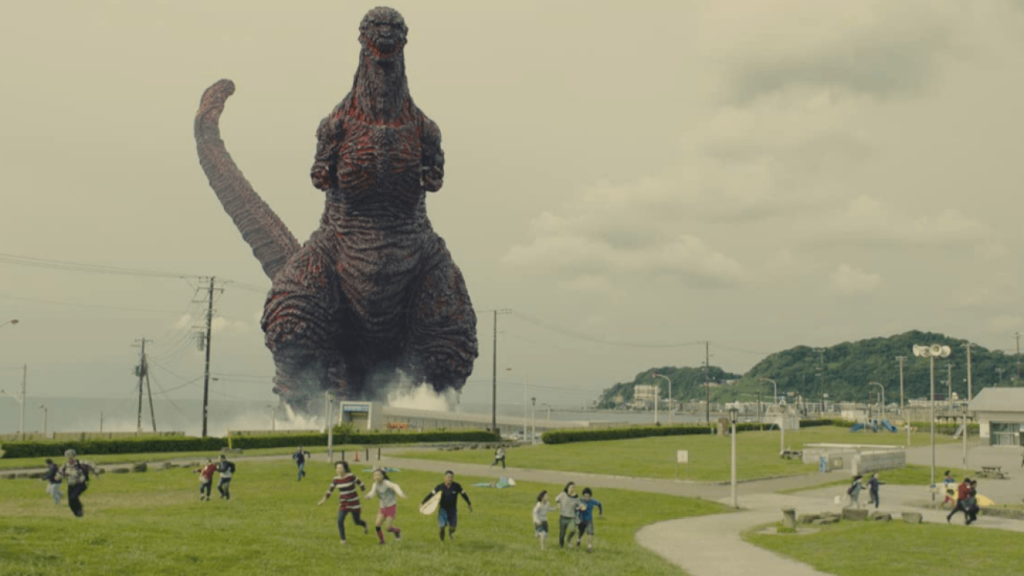Let’s face it. One of the world’s most loved monsters has experienced a softening. From decades of kid-friendly adaptations, and a handful of eye-roll inducing American remakes, Godzilla has grown into different forms that stray from the original echo of 1954 that Ishiro Honda used as a coping mechanism to illustrate the historical tragedy of the atomic bombing of Hiroshima and Nagasaki in a way that audiences could digest.
A Return to Form for Godzilla
Six decades after Godzilla first began his reign of terror, directors Hideaki Anno and Shinji Higuchi brought the original mission back with 2016’s Shin Godzilla– my personal favorite. The film was intended to echo Godzilla’s original conception, using the Fukushima Daiichi nuclear power plant disaster and the Tōhoku earthquake and tsunami from 2011 as direct references. The film performed decently with Japanese audiences, but received mixed reviews from western audiences, as it never stuck. From my own personal findings, many of the positive reviews of Shin Godzilla in the United States come from heavy horror fans. That’s not a coincidence- this rendition of the classic Godzilla story is bleaker than it has ever been before.
The story we follow is the basic kaiju monster blueprint. The Japanese coast guard investigates strange happenings off of Tokyo Bay. Authorities must come to terms with the fact that the danger is caused by a living creature after civilians capture viral footage of the entity to share online. From then, the authorities work to research the creature, and scramble to find a way to adapt.
Shin Godzilla’s 5 Forms of Terror
What makes this version different, and in my opinion, keen on horror fans, is what I call “Shin Godzilla’s 5 forms of terror,” with the last being slightly controversial. In an unexpected twist, he evolves. The monster Japan is met with is miles away from the monster we see at the end of the film. Through my American horror-obsessed eyes, I see monster perfection fueled by body horror and Lovecraftian influences told in true agony.
The Haunting Eyes of Shin Godzilla
Something I have to call attention to is the eyes. Godzilla, throughout his many metamorphoses, has eyes that lack any sense of consciousness- let alone humanity. They are the only features that remain unchanged throughout its multiple evolutions. Through the eyes viewers can feel how unfortunate this catastrophe is for all parties involved, maybe even for the monster himself. The changes this creature goes through seem so painful that the audience can imagine the collateral damage that it must cause in order to cope, seconds before we’re visually exposed to it. Imagine if a tarantula were unable to molt out of its skin- I’m no expert, but I imagine being trapped in a vessel you are quickly outgrowing would be extremely uncomfortable, suffocating, and life-threatening.
Godzilla’s Second Form: A Struggling Aquatic Monster
In the exposition of this film, we first see the monster in his official second form. It can be described as a relatively small aquatic tadpole-type creature. It wriggles on its stomach, has no arms, and is pale in color. It looks to have raw gills that can be seen secreting blood or pus. It’s clear through the design and motion that this form of Godzilla struggles to survive during the transfer from sea to land.
Godzilla’s Third Form: Adapting to Land
The third form becomes much more familiar to the traditional designs of the monster. Godzilla becomes bipedal, and his elongated neck shows that his gills have closed up. His skin darkens from a pale yellow to a soft reddish-pink like a scab to combat the loss of fluid from the previous form. Although the monster is clearly beginning to adjust to land, its rapid weight gain causes it to struggle to walk and overheat.
Godzilla’s Fourth Form: A Nuclear Powerhouse
The fourth evolution is absolutely solid. The skin emulates the texture of slightly cooled lava; a very hard crust that limits mobility, with spots of red leaking through the joints that are still able to move. The monster can now self regulate its temperature, the tail has grown exponentially, and the dorsal spikes are now fully equipped to harness the famous nuclear blast. The eyes are at their most terrifying, providing no expression- only instinct.
This is the evolution that is seemingly defeated by humanity. After discovering that the kaiju’s blood acts as a coolant, Godzilla is conquered with a coagulating agent in order to freeze his mobility, and hopefully his evolutions too. The mission is successful, and luckily the half-life of the attack is a short one, so Japan is able to begin the healing and rebuilding process.
A Final Evolution That Serves Horror
Fortunately for the fans, right before the credits roll, we are given a taste of one last evolution while the monster lays dormant. A slow pan to the tip of Godzilla’s tail reveals humanoid creatures spawning from the appendage and reaching out in agony in true Lovecraftian fashion. The fandom has named them “manzillas”, and seem to be Godzilla’s direct response to humans posing the ultimate threat to his safety. Could humanoid kaiju monsters be the defense that puts humanity six feet under?
The purists in the fandom rejected the Lovecraftian influences of the 5th form, stating that it is “not very Godzilla-like” and proposed concerns that these humanoid kaiju would replace Godzilla in the fight for survival moving forward. It’s an argument not worth digging into, as Toho has confirmed Shin Godzilla will not be granted a continuation, but the horror fans will remember…
I’m just a horror girl who loves monsters, but I have to credit the dedicated fans who live in the Godzilla fandom. There are tons of essays, videos, and theories out there on the internet to explain any fandom phenomenon in full detail.
Check out this fan animation of Shin Godzilla’s size comparisons.
